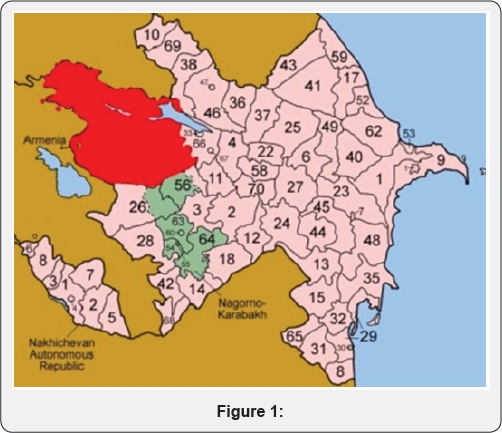Scientific Substantiation of Introduction of Differentiated Agricultural Systems, Increase of Productivity of Agricultural Production - Juniper Publishers
Journal of Trends in Technical and Scientific Research
Abstract
As a result of the agrarian reforms implemented in
the Republic of Azerbaijan, the basis for the dynamic development of
agriculture was created. Major changes have been made in the agrarian
sector, new economic and property relations have been formed, the
normative legal base has been improved. An important issue has been
raised to improve the quality of erosion lands and the productivity of
agricultural crops.
Keywords: Humus; Soil; Erosion; Layer; Ostepennye; Not washed
Introduction
For solving various practical issues and in the first
place, the most rational distribution of crops and increase their
productivity soil must be evaluated, taking into account their quality
and its changing under the influence of industrial activity.
To that end, it had explored common at the site soil
research natural areas. Their evaluation was performed from the basis of
agrochemical and water-physical properties of soils, impact their
erosion and yield of different Soils crop farming zone estimated
reserves of humus, nitrogen, phosphorus, absorption capacity and some
water-physical properties in 0-20cm 0-50cm and 0-100cm of soil layers.
Scientific and reasonable accommodation,
differentiated farming system on the basis of the evaluation provides an
opportunity to improve crop productivity. Among soils agricultural zone
natural fertility indicators highest impact mining nesmytye Brown
ostepnennye soil. Taken as a “benchmark”. Points remaining soils
distributed in these areas also are calculated as a percentage of the
standard. To manage associations and groupings of soils comprising the
agricultural zone and heavily used in agricultural production, they are
grouped into the following five groups: land better, good, medium, low
and very low dignity. In a fairly fractional grouping soil laid down the
objective indicators of soil fertility and their productivity [1].
At the same time grouping based on commonality land
allows rationally and purposefully uses soil from the agricultural point
of view. The following will focus on agroproizvodstvennoj
characteristic of designated groups. S Group-land better dignity. This
group includes mining and nesmytye Brown ostepnennye soil, area of 9565,
0 hectares or 23, 89% of the total area of agricultural areas of
evaluation scores 81.
Stocks of humus, gross phosphorus and nitrogen
absorption capacity in 0-20cm of soil layers is 124,11 t/ha; 7,23 t/ha;
6,21 t/ha and 38,87mg/eq on 100 g of soil in 0-50cm layers respectively
223,42 t/ha; 15,41 t/ha; 12,62 tons/ha and 38,17mg/eq on 100g of soil,
and in 0-100cm layers of 327,32 t/ ha; 18.26 t/ha; 17,65 t/ha and mg/eq
41,23 on 100g of soil [2].

For soils of this group did not require special
erosion control activities. In order to maintain the natural fertility
of these soils vineyards, ploughing, seeding and tillage should be
conducted across a slope, to observe the erosion, and agricultural
activities. ENJOY Group-land of good merit the land Area is 13783.5
hectares, or 11.24% of the total area of agricultural zone. They are
priced ranging from 61 to 80 points on the bonitetnoj scale. This group
includes the slabosmytye mountain-Brown, ostepnennye nesmytye and
slabosmytye mountain grey-brown, nesmytye and slabosmytye mountain dark
brown (dark grey-brown) and floodplain meadow soils Figure 1.
Stocks see 0-20 layer of humus in these soils reach
57, 63 -95, 12 t/ha, 0-50cm layers of 131, 89-208, 20t/ha, and the meter
layers 186, 44 -301,32t/ha. Compared with the first group, this group
is less assured in nutrients. Gross nitrogen content and gross
phosphorus in 0-20cm kalebletsja layer in the range from 3.57 to
5.29tons/ha and 3.28-4.97t/ha, 0-50cm layers of 7,80 -11,31t/ha and 7,80
-11,60t/ha, and the meter layers respectively 9.10 -16.12t/ha and 11.16
-18.88t/ha. In 0-20, see tank takeover layers varies between-36.27
28.32mg/eq on 100g of soil, and in 0-50cm layers respectively
27.50-36.04mg/ eq on 100g of soil. When you use these lands must follow
the General Agro technical measures protective nature envisaged for
lands S Group [3]. To maintain and improve the productivity of
vegetation and prevent erosion on pasture standards must be respected to
settlements pastures for and enter the moving system of grazing, to
make chemical fertilizers. Good graphics, decent game play Group-land of
the middle area of the dignity in that group of soils is 8130,0
hectares or 20,30% of the total area of the agricultural area.
These soils are evaluated in 41-60 points. This group
comprises small and srednesmytye mining-Brown, ostepnennye slabosmytye
mountain grey-brown, slabosmytye mountain-dark brown (dark grey-brown)
and the nesmytye mountain light brown (light greyish-Brown) soil. In
these soils, stockpiles of humus, gross gross phosphorus and nitrogen
absorption capacity in 0-20cm layer vary between 60.24 -63.01t/ha, 3.78
-3.84t/ha, -3,35 2,83t/ha and 28,77 -30,43mg/eq on 100g of soil, and in
0-50cm layer 87,78 -131,89 respectively, t/ha, 5,32m/ -7.86 ha, -6,05
5,99 t/ha and 27,71 -30,17mg/eq on 100g of soil [4].
When using the medium need dignity lands activities
implement agro technical measures of a general nature applicable to land
first and second teams, and the eroded sections carry out anti-erosion
agricultural activities. The eroded areas of arable land use strip crops
and strip buffers from perennial grasses. If necessary, a small part of
the plots on arboraceous over 20° used for crops, perennial grasses,
then using them as hayfields. Introduced mineral fertilizers. On
slobosmytyh sites, reduce grazing on rule 25% due to nejerodirovannyh
plots and observe the sequence of grazing. Rocky areas cleared of
stones. YV Group-land of low land worthiness this group is 8115, 0
hectares or 20,27% of the total area of agricultural zones, they are
priced from 21 to 40 points. This group includes the silnosmytye
mountain-Brown ostepnennye, medium and silnosmytye mountain-Brown,
medium and silnosmytye mountain dark brown (dark grey- brown) and the
slobosmytye mountain light brown (light greyish-Brown) soil [5].
Stocks of humus in 0-20 see these layers of soil
reach 36.83 -60.72 t/ha, polumetrovyh layers of 73,36 -115,29 t/ha, and
the meter layers 126,69 -241,80 t/ha. Gross reserves of nitrogen vary in
0-20 see layers from 2.79 to 3.84 t/ha, gross phosphorus 1,78 -3,00
t/ha, absorption capacity -29,65 26,16mg/eq on 100g of soil, and in
0-50cm layers accordingly: from 5,32 to 5,90 t/ ha, 3,93 -6,30 t/ha, and
23,84 -27,86mg/eq on 100g of soil [6].
To restore the soil fertility in srednesmytyh and
silnosmytyh areas it is necessary to carry out the planting of perennial
grasses and apply erosion event, featured for all previous groups to
settlements pastures for pasture grazing rules on reduced 50%.
In Group-very low land worthiness. This group
includes silnosmytye mountain gray-Brown and Silnosmytye Mountain dark
brown (dark grey-brown) soils and evaluated up to 20 credits. These
lands is 667.5hectares or 1.67% of the total area agricultural zone.
Stocks of humus, gross phosphorus and nitrogen absorption capacity in
0-20cm layer accounted for 33.26-36.54 t/ha; 2.02 -2.42 t/ha; 1.51 -1.94
t/ha and 25.02 -26.40mg/eq, and in 0-50cm layer respectively 78.08
-81.25 t/ ha; -5.00 3.84 t/ha; 3.20 -3.75 t/ha and -24.82 23.56mg/eq on
100g of soil. When you use these lands must observe activities previous
land groups, and to restore the strongly rarefied grass would need
additional erosion event, stone-clearing, etc.
To Know More About Trends in Technical and ScientificResearch Please click on:
https://juniperpublishers.com/ttsr/index.php
To Know More About Open Access Journals Please click on:
https://juniperpublishers.com/index.php
https://juniperpublishers.com/index.php



Comments
Post a Comment